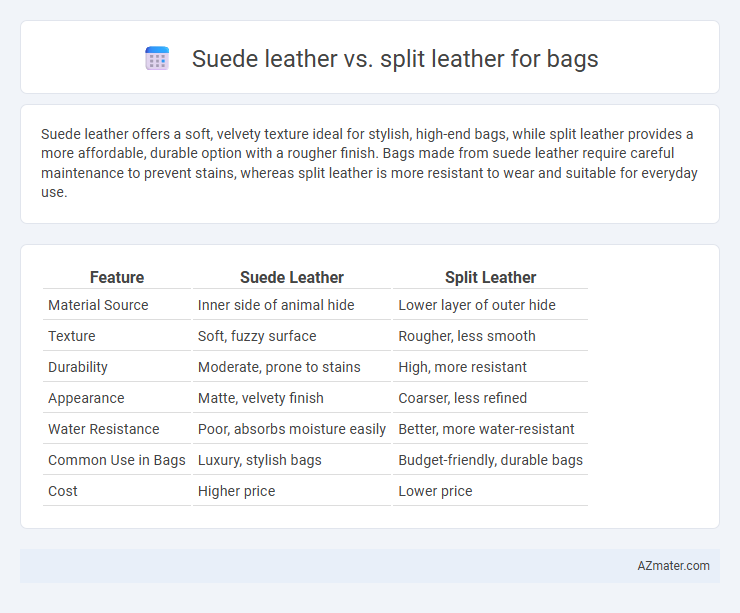Suede leather offers a soft, velvety texture ideal for stylish, high-end bags, while split leather provides a more affordable, durable option with a rougher finish. Bags made from suede leather require careful maintenance to prevent stains, whereas split leather is more resistant to wear and suitable for everyday use.
Table of Comparison
| Feature | Suede Leather | Split Leather |
|---|---|---|
| Material Source | Inner side of animal hide | Lower layer of outer hide |
| Texture | Soft, fuzzy surface | Rougher, less smooth |
| Durability | Moderate, prone to stains | High, more resistant |
| Appearance | Matte, velvety finish | Coarser, less refined |
| Water Resistance | Poor, absorbs moisture easily | Better, more water-resistant |
| Common Use in Bags | Luxury, stylish bags | Budget-friendly, durable bags |
| Cost | Higher price | Lower price |
Introduction: Understanding Suede Leather vs Split Leather
Suede leather, derived from the inner surface of animal hides, offers a soft, velvety texture prized for luxury bags, while split leather is produced by mechanically splitting the lower layers of the hide, providing a more affordable but less durable option. Suede's fine nap and flexibility make it ideal for stylish, high-end bags, whereas split leather often requires surface treatments like embossing or coating to enhance appearance and durability. Bag manufacturers select between suede and split leather based on factors such as desired texture, strength, and cost-effectiveness for target markets.
What is Suede Leather?
Suede leather is made from the underside of animal hides, primarily cowhide, offering a soft, napped finish known for its velvety texture and delicate appearance. Unlike split leather, which is derived from the lower layers of the hide and often coated to resemble full-grain leather, suede's porous surface absorbs moisture easily and requires special care to maintain durability. Bags crafted from genuine suede leather provide a luxurious feel and aesthetic but may be less resistant to wear and environmental factors compared to split leather alternatives.
What is Split Leather?
Split leather is created by separating the fibrous part of the hide from the outer grain layer, resulting in a material that is less durable and less expensive than full-grain or suede leather. It is often coated or embossed to mimic the appearance of top-grain leather but lacks the natural texture and strength found in suede leather, which is made from the inner split of the hide with a soft, napped finish. Bags made from suede leather offer superior softness and aesthetic appeal, while split leather bags are more budget-friendly but prone to quicker wear and reduced breathability.
Key Differences Between Suede and Split Leather
Suede leather, made from the underside of the animal hide, features a soft, napped finish with a luxurious texture, while split leather is derived from the fibrous part of the hide left after the top grain is separated, often coated or treated for durability. Suede is more prone to staining and requires careful maintenance, whereas split leather offers greater resistance to wear and is commonly used in budget-friendly bags. Key differences include texture, durability, and cost, with suede favored for its aesthetic appeal and split leather chosen for functional uses.
Appearance and Texture Comparison
Suede leather exhibits a soft, velvety surface with a matte finish, offering a luxurious and tactile appeal ideal for high-end bags. Split leather, derived from the lower layers of hide, features a coarser texture and less uniform appearance, often requiring further treatment or embossing to enhance its look. The distinct nap of suede creates a plush texture that darkens with wear, while split leather presents a more rugged and less refined surface.
Durability and Longevity
Suede leather, crafted from the underside of animal hides, offers a soft texture but is less durable and more prone to wear compared to split leather, which is made by splitting the hide's fibrous part and is thicker and sturdier. Split leather bags tend to resist scratches and tears better, providing greater longevity for everyday use. Choosing split leather enhances bag durability, making it ideal for long-term investment pieces.
Maintenance and Care
Suede leather requires regular brushing with a soft brush to remove dirt and maintain its soft texture, while avoiding water exposure to prevent stains. Split leather, being less durable and more porous, needs frequent conditioning with leather-specific products to prevent drying and cracking. Both types benefit from protective sprays, but suede demands gentler, specialized care to preserve its unique nap and appearance.
Cost Comparison: Suede vs Split Leather
Suede leather typically costs more than split leather due to its higher quality and the additional processing required to create its soft, velvety texture. Split leather, derived from the lower layers of a hide, is less expensive but also less durable and less aesthetically refined compared to suede. For bags, choosing suede often means investing in superior appearance and longevity, while split leather options provide more budget-friendly alternatives with a rougher finish.
Best Uses for Bags: Suede or Split Leather?
Suede leather, known for its soft texture and luxurious appearance, is best suited for fashion-forward bags that prioritize style and a delicate touch, often used in handbags, clutches, and evening bags. Split leather, derived from the fibrous lower layer of hide, offers greater durability and resistance to wear, making it ideal for everyday bags, backpacks, and messenger bags where toughness and longevity are essential. Choosing between suede and split leather depends on whether the bag's primary function is aesthetic appeal or rugged practicality.
Conclusion: Which Leather is Right for Your Bag?
Suede leather offers a soft, luxurious texture ideal for stylish, high-end bags but requires careful maintenance to prevent stains and wear. Split leather is more durable and budget-friendly, making it suitable for everyday bags that endure heavy use. Choose suede for elegance and softness, or split leather for affordability and resilience, depending on your bag's intended purpose and care commitment.

Infographic: Suede leather vs Split leather for Bag
 azmater.com
azmater.com